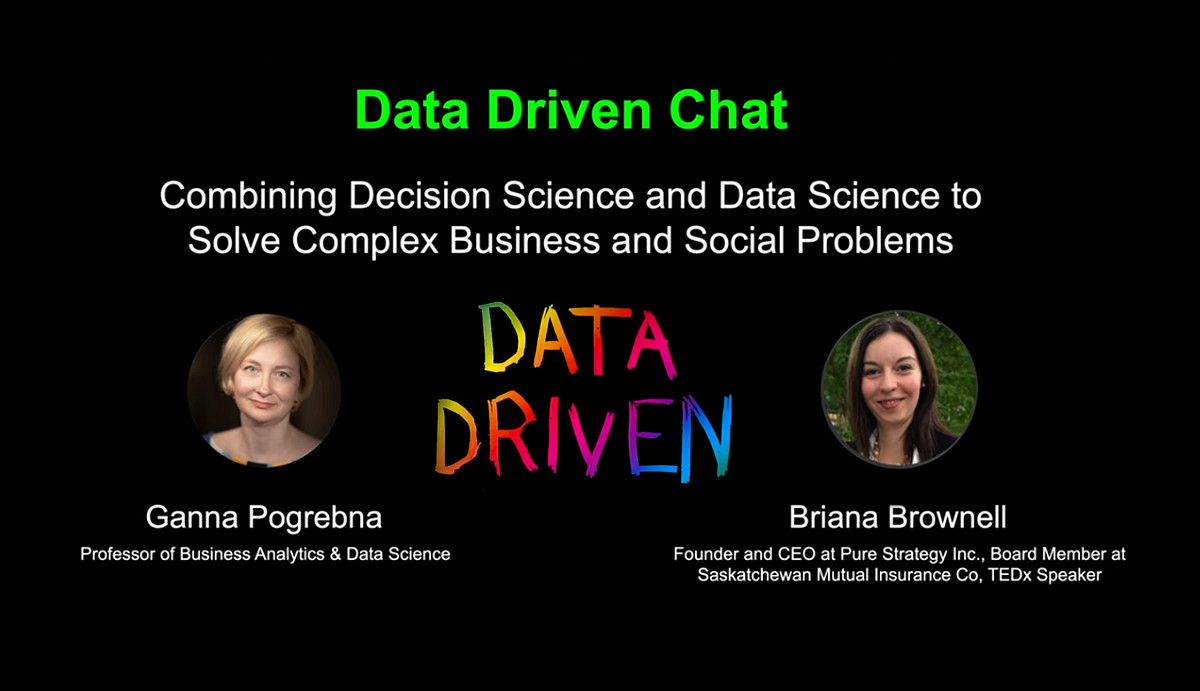Academic, Educator, Consultant, and Blogger Ganna Pogrebna started Data Driven Chat to explore the many interesting aspects of behavioural data science including human behaviour, data science and AI. Ganna Pogrebna is Professor of Behavioral Analytics and Data Science and a Lead of Behavioral Data Science strand at the Alan Turing Institute — the national centre for AI and Data Science in London (UK). The Data Driven Chat is the official podcast of the Behavioral Data Science Special Interest Group at Turing.
Data scientist turned tech entrepreneur Briana Brownell is the founder and CEO of Pure Strategy Inc. Using the leading edge technology in natural language processing, machine learning and neural networks Pure Strategy’s Automated Neural Intelligence Engine (ANIE) gives organizations the insights needed to make decisions confidently.
The conversation originally appeared on Data Driven Chat. Click here to listen.
This is Part 2 of a three-part series. You can read Part 1 and Part 3 here.
Ganna: We’ll come back to the topic of Covid-19 a bit later but first, I want to ask you — a lot of people who listen to this podcast are aspiring data scientists and trying to find a place in data science. Can you give some tips to people who want to get into this kind of liaison between decision science and data science? Where do they start? What do they need to do?
Briana: I think that the underappreciated skill in data science is communication and business acumen. Having the technical skills to run the models and be able to do those technical things like programming in Python and understanding databases are really important but the truth is, when you’re working in industry, it’s all about how that analysis can impact the metrics that the business cares about. So if you are not able to link what you’re doing to a goal that the business has or an outcome that’s really important, it’s really really hard to get resources and it’s difficult to be effective if you’re doing something that is not a high priority within the business.
“I think that the underappreciated skill in data science is communication and business acumen.”
This is where I see data scientists really struggling. In an organization, when you do modelling with data that isn’t linked to any kind of outcome, these teams often get pushed to the side or they get minimized within the organization. It’s so sad because data science can be so impactful.
Technical skills extremely important but being able to communicate the value of that to the business is even more important.
Ganna: Yeah certainly — and you mentioned that what is also important is the problem statements, right? How do you support answering important questions for business? That’s another thing that everybody needs to be able to do as an aspiring data scientist. How do we approach data in the business context? Why do you think understanding data is particularly important for businesses now? Do you think the potential of data is still not realized?
Briana: Great questions. I do think that the potential of data is not realized in most organizations and there are several reasons for this. The first one is siloed data within organizations. I’ve worked with organizations where they had multiple teams that were essentially collecting the same information but because of political reasons within the organization, they were unwilling to share that data back and forth across departments. I think that’s really dangerous because that’s a sign of a poorly functioning organization. If there’s no way to share data across different groups in the organization, that’s always a challenge.
Second, individuals often don’t know what’s possible with data, especially when you get to the c-suite and the executive level. All of these techniques are so new it’s difficult to know exactly what the payoff might be in doing a larger scale analysis project within the organization. Sometimes the project essentially is a failure and sometimes you can get additional insight but you don’t necessarily know until you try. That’s sometimes a real barrier when executives want to see certain ROI on their data programs.
Ganna: And how did data change the business landscape in the last few years or did it change? Do you observe the change?
Briana: I think that the biggest change in how data is used in organizations is that, say 10 years ago, it was rare to have a data project make it all the way up to the c-suite or the board level. The executives would never actually see any results of a data analytics project. They would be within the marketing group, they might be within the IT group or they might be within the sales group. They were kept within those small silos and they would never make it up to the executive level in the organization.
But after people started seeing the value of it, we started seeing buy-in at the highest levels of the organization. Not only were executives asking for better data, better analytics, better modelling, but boards of directors were asking for it. You saw a board mandate saying “We need to have some kind of data-driven metric for each quarter. We need to see this metric.”
“All of this information went to the highest levels of the organization and that, I think, was a really new thing.”
All of this information went to the highest levels of the organization and that, I think, was a really new thing. Before, a lot of financial metrics were always reported to the board and the executive but now the marketing metrics, the operations research metrics, all of these areas are finding themselves in the boardroom and I think that that’s a really positive sign.
#business-strategy #data-science #technology #business #data #data analysis
